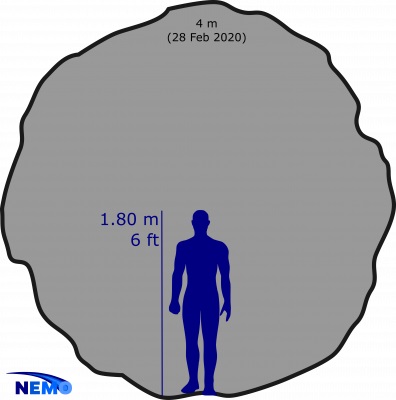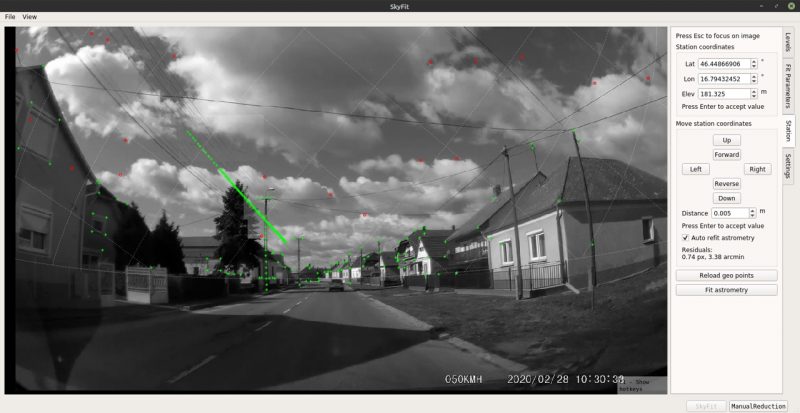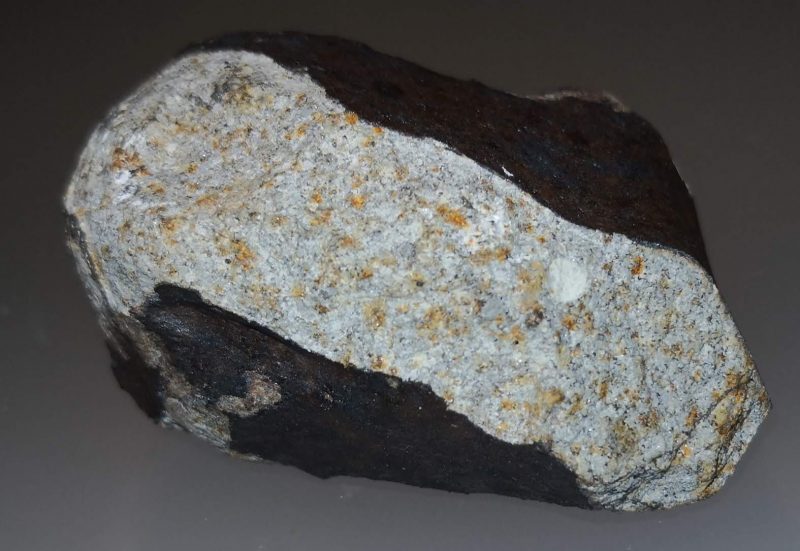On February 28, 2020, around 10:35 in the morning, people around the Adriatic Sea looked up to see a bright burst of light streaking toward Earth. Dashcams, security cameras, and even a bike helmet recorded this daylight fireball as it plunged through our atmosphere. The meteor broke into pieces as it heated up, scattering across the land. Denis Vida of the University of Western Ontario gave a presentation at the Europlanet Science Congress virtual meeting in September 2021 showing how they were able to reconstruct the trajectory of the fireball using the videos.
Witnesses to the daylight fireball
Slovenians directly under the path of the fireball reported hearing loud explosions and saw the fireball for 3 1/2 seconds as it flashed, broke up and left a trail of dust in the morning sky. The International Meteor Organization received 70 eyewitness reports of the fireball from Slovenia, Croatia, Italy, Hungary, Austria and even one in Germany. The observer from Germany reported it as:
Impressively beautiful!
While one witness identified as Alegra J. in Croatia said:
I didn’t hear a sound but I did feel a sort of wave as I was watching. Also, suddenly the sky was full of birds flying very high.

Analyzing the fireball
The videos showed the fireball breaking up into 17 pieces. U.S. government sensors detected the object entering Earth’s atmosphere and said it had a velocity of 13.3 miles per second (21.5 km/s), and an energy of 0.34 kiloton of TNT. The Infrasound Monitoring System, part of the Comprehensive Nuclear-Test-Ban Treaty Organization, also measured the waveform at two infrasound stations, which measure pressure changes in the atmosphere. Scientists were able to measure what the size of the stony asteroid would have been before entering our atmosphere: an impressive 13 feet (4 meters) in diameter, with a mass of 90 tons.

Tracking the meteorite to the ground
Meteorites are valuable to scientists because they provide physical evidence of the history of our solar system. They may even help us understand how life arose on Earth and if it spread throughout the solar system. So, once fireball reports come in, it’s important to collect the remains from the ground.
In order to track down and collect valuable meteorites, astronomers have networks of cameras to measure the precise paths of fireballs. Measurements from the cameras enable scientists to track the space rock to the ground and also back to where it came from. But scientists designed these cameras to work at night to compare the position of the fireball to the positions of background stars. Vida explains how this daylight fireball made tracking more challenging:
By combining observations from several cameras around 100 kilometers [60 miles] apart, a fireball’s position can be pinpointed to within 50 meters [about 160 feet], and it’s usually fairly easy to compute its atmospheric trajectory and pre-atmospheric orbit this way. The fireball’s path is in a volume of the world’s sky among the most densely observed by specialist night-operating cameras. Its path would have been caught by at least 20 if it happened just a few hours earlier. But because this fireball occurred during the day and was recorded by dash cameras moving up to 70 kilometers per hour [over 40 mph], we required a different approach.
Getting the community involved
The scientists enlisted locals to take photographs from locations of buildings, landmarks, telephone poles and other spots visible in the fireball videos. Using the images, the scientists could triangulate exact locations to within inches. Locals took photographs on starry nights, so scientists could calibrate from window frames to rooftops until every pixel on the original images had a precise direction. It was particularly tricky to get the exact coordinates from the dashcams of moving vehicles.

Meteorite recovery from the daylight fireball
A man near Novo Mesto in Slovenia found the first piece of the meteorite from the fireball on his driveway on March 4, 2020. The meteorite measured in at 203 grams, or about half a pound. In total, locals recovered three meteorites from the fireball totaling 720 grams, which are now being analyzed in labs. Videos showed the largest piece should be about 22 pounds, or 10 kilograms, but it is as-yet unrecovered. Bojan Ambrožic, a scientist who confirmed the extraterrestrial origin of the meteorite from the driveway, said:
There are probably dozens more in the vicinity of Novo Mesto, if we are optimistic maybe even hundreds.

Vida’s team of scientists made calculations to reveal just what kind of pressure the meteoroid was under as it burned up upon entering Earth’s protective atmosphere. They found that some of the recovered meteorites survived aerodynamic pressures above ten million pascals, which is equivalent to 50 times the pressure of a car tire. This is one of the highest measurements recorded for a meteorite.
Scientists continue to study the Novo Mesto space rock. So far it appears to be an ordinary chondrite type of meteorite. Scientists link the meteorite to the region of space where Near-Earth objects reside, where potentially hazardous asteroids lurk.
Bottom line: Scientists tracked a daylight fireball to Earth using images from video of the event that occurred over countries near the Adriatic Sea.
Spot a meteor or maybe even a fireball with the help of EarthSky’s 2021 Meteor Shower Guide.
The post Daylight fireball tracked to Earth first appeared on EarthSky.
from EarthSky https://ift.tt/2Y5ObRa
On February 28, 2020, around 10:35 in the morning, people around the Adriatic Sea looked up to see a bright burst of light streaking toward Earth. Dashcams, security cameras, and even a bike helmet recorded this daylight fireball as it plunged through our atmosphere. The meteor broke into pieces as it heated up, scattering across the land. Denis Vida of the University of Western Ontario gave a presentation at the Europlanet Science Congress virtual meeting in September 2021 showing how they were able to reconstruct the trajectory of the fireball using the videos.
Witnesses to the daylight fireball
Slovenians directly under the path of the fireball reported hearing loud explosions and saw the fireball for 3 1/2 seconds as it flashed, broke up and left a trail of dust in the morning sky. The International Meteor Organization received 70 eyewitness reports of the fireball from Slovenia, Croatia, Italy, Hungary, Austria and even one in Germany. The observer from Germany reported it as:
Impressively beautiful!
While one witness identified as Alegra J. in Croatia said:
I didn’t hear a sound but I did feel a sort of wave as I was watching. Also, suddenly the sky was full of birds flying very high.

Analyzing the fireball
The videos showed the fireball breaking up into 17 pieces. U.S. government sensors detected the object entering Earth’s atmosphere and said it had a velocity of 13.3 miles per second (21.5 km/s), and an energy of 0.34 kiloton of TNT. The Infrasound Monitoring System, part of the Comprehensive Nuclear-Test-Ban Treaty Organization, also measured the waveform at two infrasound stations, which measure pressure changes in the atmosphere. Scientists were able to measure what the size of the stony asteroid would have been before entering our atmosphere: an impressive 13 feet (4 meters) in diameter, with a mass of 90 tons.

Tracking the meteorite to the ground
Meteorites are valuable to scientists because they provide physical evidence of the history of our solar system. They may even help us understand how life arose on Earth and if it spread throughout the solar system. So, once fireball reports come in, it’s important to collect the remains from the ground.
In order to track down and collect valuable meteorites, astronomers have networks of cameras to measure the precise paths of fireballs. Measurements from the cameras enable scientists to track the space rock to the ground and also back to where it came from. But scientists designed these cameras to work at night to compare the position of the fireball to the positions of background stars. Vida explains how this daylight fireball made tracking more challenging:
By combining observations from several cameras around 100 kilometers [60 miles] apart, a fireball’s position can be pinpointed to within 50 meters [about 160 feet], and it’s usually fairly easy to compute its atmospheric trajectory and pre-atmospheric orbit this way. The fireball’s path is in a volume of the world’s sky among the most densely observed by specialist night-operating cameras. Its path would have been caught by at least 20 if it happened just a few hours earlier. But because this fireball occurred during the day and was recorded by dash cameras moving up to 70 kilometers per hour [over 40 mph], we required a different approach.
Getting the community involved
The scientists enlisted locals to take photographs from locations of buildings, landmarks, telephone poles and other spots visible in the fireball videos. Using the images, the scientists could triangulate exact locations to within inches. Locals took photographs on starry nights, so scientists could calibrate from window frames to rooftops until every pixel on the original images had a precise direction. It was particularly tricky to get the exact coordinates from the dashcams of moving vehicles.

Meteorite recovery from the daylight fireball
A man near Novo Mesto in Slovenia found the first piece of the meteorite from the fireball on his driveway on March 4, 2020. The meteorite measured in at 203 grams, or about half a pound. In total, locals recovered three meteorites from the fireball totaling 720 grams, which are now being analyzed in labs. Videos showed the largest piece should be about 22 pounds, or 10 kilograms, but it is as-yet unrecovered. Bojan Ambrožic, a scientist who confirmed the extraterrestrial origin of the meteorite from the driveway, said:
There are probably dozens more in the vicinity of Novo Mesto, if we are optimistic maybe even hundreds.

Vida’s team of scientists made calculations to reveal just what kind of pressure the meteoroid was under as it burned up upon entering Earth’s protective atmosphere. They found that some of the recovered meteorites survived aerodynamic pressures above ten million pascals, which is equivalent to 50 times the pressure of a car tire. This is one of the highest measurements recorded for a meteorite.
Scientists continue to study the Novo Mesto space rock. So far it appears to be an ordinary chondrite type of meteorite. Scientists link the meteorite to the region of space where Near-Earth objects reside, where potentially hazardous asteroids lurk.
Bottom line: Scientists tracked a daylight fireball to Earth using images from video of the event that occurred over countries near the Adriatic Sea.
Spot a meteor or maybe even a fireball with the help of EarthSky’s 2021 Meteor Shower Guide.
The post Daylight fireball tracked to Earth first appeared on EarthSky.
from EarthSky https://ift.tt/2Y5ObRa

Aucun commentaire:
Enregistrer un commentaire